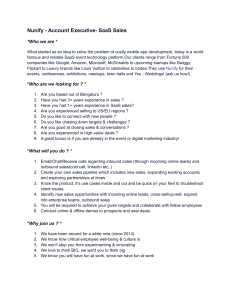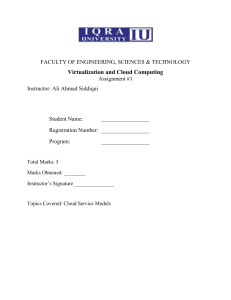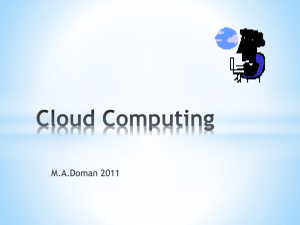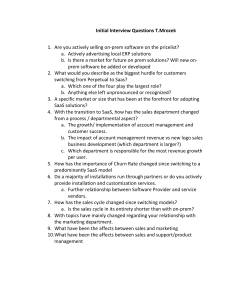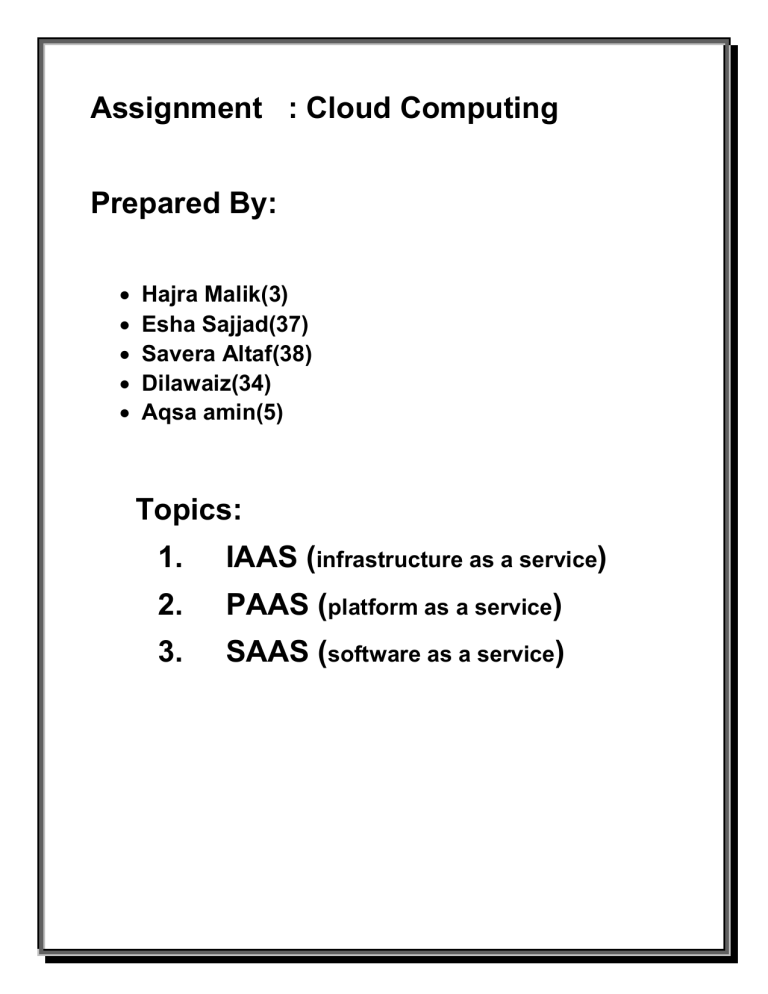
Assignment : Cloud Computing Prepared By: Hajra Malik(3) Esha Sajjad(37) Savera Altaf(38) Dilawaiz(34) Aqsa amin(5) Topics: 1. IAAS (infrastructure as a service) 2. PAAS (platform as a service) 3. SAAS (software as a service) IAAS (Infrastructure as a service) Cloud service models There are three cloud service models: 1. Software as a Service (SaaS) 2. Platform as a Service (PaaS) 3. Infrastructure as a Service (IaaS) Each cloud service model provides a level of abstraction that reduces the efforts required by the service consumer to build and deploy systems Definition Infrastructure-as-a-Service (IaaS) is the delivery of computer infrastructure (typically a platform virtualization environment) as a service. IaaS leverages significant technology, services, and data center investments to deliver IT as a service to customers. IaaS is Centered around a model of service delivery that provisions a predefined, standardized infrastructure specifically optimized for the customer’s applications. Example One example we will examine is Amazon’s Elastic Compute Cloud (Amazon EC2). Benefits Rather than purchasing data center space, servers, software, network equipment, etc., IaaS customers essentially rent those resources as a fully outsourced service. Usually, the service is billed on a monthly basis, just like a utility company bills customers. The customer is charged only for resources consumed. The chief benefits of using this type of outsourced service include: Ready access to a preconfigured environment that is generally ITILbased5 (The Information Technology Infrastructure Library [ITIL] is a customized framework of best practices designed to promote quality computing services in the IT sector.) Use of the latest technology for infrastructure equipment. Secured, “sand-boxed” (protected and insulated) computing platforms that are usually security monitored for breaches. Reduced risk by having off-site resources maintained by third parties Ability to manage service-demand peaks and valleys. Lower costs that allow expensing service costs instead of making capital investments. Reduced time, cost, and complexity in adding new features or capabilities With IaaS, the virtual infrastructure is available on demand and can be up and running in minutes by calling an application programming interface (API) or launching from a web-based management console. Vendors: The most mature and widely used IaaS cloud service provider is Amazon Web Services (AWS). IaaS providers manage the transition and hosting of selected applications on their infrastructure. Customers maintain ownership and management of their application(s) while off-loading hosting operations and infrastructure management to the IaaS provider. Provider-owned implementations typically include the following layered components: Computer hardware (typically set up as a grid for massive horizontal scalability) Computer network (including routers, firewalls, load balancing, etc.) Internet connectivity (often on OC 192 backbones4 ) Platform virtualization environment for running client-specified virtual machines Service-level agreements Utility computing billing Characteristics: Characteristics of IaaS systems include: Automated administrative tasks Dynamic scaling Platform virtualization technology GUI and API-based access Internet connectivity Dynamic scalability Full control of instances Configuration flexibility Services: Compute Storage Network Load balancing Drawbacks: Security risks Customization problems Limited support Large costs SAAS (Software as a service) The traditional model of software distribution, in which software is purchased for and installed on personal computers, is sometimes referred to as Software-as-a-Product. Software-as-a-Service is a software distribution model in which applications are hosted by a vendor or service provider and made available to customers over a network, typically the Internet. SaaS is becoming an increasingly prevalent delivery model as underlying technologies that support web services and service-oriented architecture (SOA) mature and new developmental approaches become popular. SaaS is also often associated with a pay-as-you-go subscription licensing model. Meanwhile, broadband service has become increasingly available to support user access from more areas around the world. Services: SaaS is most often implemented to provide business software functionality to enterprise customers at a low cost while allowing those customers to obtain the same benefits of commercially licensed, internally operated software without the associated complexity of installation, management, support, licensing, and high initial cost. SaaS solutions were developed specifically to work within a web browser. The architecture of SaaS-based applications is specifically designed to support many concurrent users (multitenancy) at once. Key Characteristics of SaaS: The key characteristics of SaaS software are the following: Network-based management and access to commercially available software from central locations rather than at each customer’s site, enabling customers to access applications remotely via the Internet. Application delivery from a one-to-many model (single-instance, multitenant architecture), as opposed to a traditional one-to-one model. Centralized enhancement and patch updating that obviates any need for downloading and installing by a user. SaaS is often used in conjunction with a larger network of communications and collaboration software, sometimes as a plug-in to a PaaS architecture. Benefits of the SaaS Model The SaaS model helps enterprises ensure that all locations are using the correct application version and, therefore, that the format of the data being recorded and conveyed is consistent, compatible, and accurate. SaaS also helps to increase the availability of applications to global locations. SaaS also ensures that all application transactions are logged for compliance purposes. The benefits of SaaS to the customer are very clear: Streamlined administration Automated update and patch management services Data compatibility across the enterprise (all users have the same version of software) Facilitated, enterprise-wide collaboration Global accessibility SaaS Implementation Issues: According to Microsoft, 14 SaaS architectures can be classified into one of four maturity levels whose key attributes are ease of configuration, multitenant efficiency, and scalability. Each level is distinguished from the previous one by the addition of one of these three attributes. The levels described by Microsoft are as follows. SaaS Architectural Maturity Level 1—Ad-Hoc/Custom. The first level of maturity is actually no maturity at all. Each customer has a unique, customized version of the hosted application. The application runs its own instance on the host’s servers. Migrating a traditional non-networked or client-server application to this level of SaaS maturity typically requires the least development effort and reduces operating costs by consolidating server hardware and administration. SaaS Architectural Maturity Level 2—Configurability. The second level of SaaS maturity provides greater program flexibility through configuration metadata. At this level, many customers can use separate instances of the same application. This allows a vendor to meet the varying needs of each customer by using detailed configuration options. It also allows the vendor to ease the maintenance burden by being able to update a common code base. SaaS Architectural Maturity Level 3—Multitenant Efficiency. The third maturity level adds multitenancy to the second level. This results in a single program instance that has the capability to serve all of the vendor’s customers. This approach enables more efficient use of server resources without any apparent difference to the end user, but ultimately this level is limited in its ability to scale massively. SaaS Architectural Maturity Level 4—Scalable. At the fourth SaaS maturity level, scalability is added by using a multitiered architecture. This architecture is capable of supporting a load-balanced farm of identical application instances running on a variable number of servers, sometimes in the hundreds or even thousands. System capacity can be dynamically increased or decreased to match load demand by adding or removing servers, with no need for further alteration of application software architecture. (PaaS) (Platform-as-a-Service) “Cloud computing has evolved to include platforms for building and running custom web-based applications, a concept known as Platform-as-a Service. PaaS is an outgrowth of the SaaS application delivery model. The PaaS model makes all of the facilities required to support the complete life cycle of building and delivering web applications and services entirely available from the Internet, all with no software downloads or installation for developers, IT managers, or end users.” Key Characteristics of PaaS Chief characteristics of PaaS include services to develop, test, deploy, host, and manage applications to support the application development life cycle. Web-based user interface creation tools typically provide some level of support to simplify the creation of user interfaces, based either on common standards such as HTML and JavaScript or on other, proprietary technologies. PaaS providers often include services for concurrency management, scalability, fail-over and security. Another characteristic is the integration with web services and databases. Support for Simple Object Access Protocol (SOAP) and other interfaces allows PaaS offerings to create combinations of web services (called mashups) as well as having the ability to access databases and reuse services maintained inside private networks. The ability to form and share code with ad-hoc, predefined, or distributed teams greatly enhances the productivity of PaaS offerings. Extensions in PAAS • Logging • Monitoring • Security • Caching • Search • E-mail • Analytics • Payments Example Heroku and Engine Yard are examples of mature public PaaS solutions that provide multiple stacks for developers. Benefits Another huge advantage of PaaS is that these platforms integrate with numerous third-party software solutions, which are often referred to as plugins, add-ons, or extensions. Operational tools in place so developers can create custom software Rapidly add capacity in peak times and scale down as needed PaaS providers invest heavily in security technology and expertise Limitations in PAAS: • Incompatibilities with current systems • Poor access to support • Necessary third-party services incongruous with current business model • No way to manage security in-house • Limitations based on product functionality • Challenges in transitioning from one platform to another

